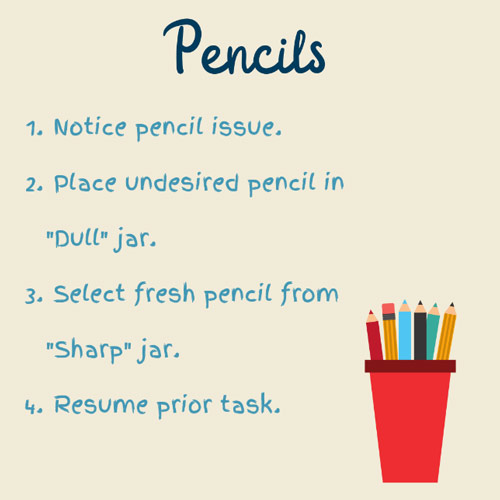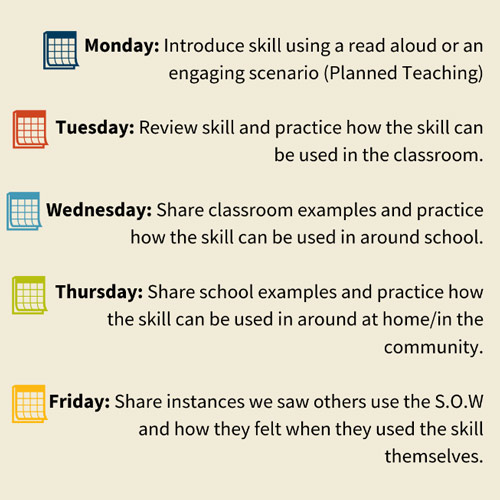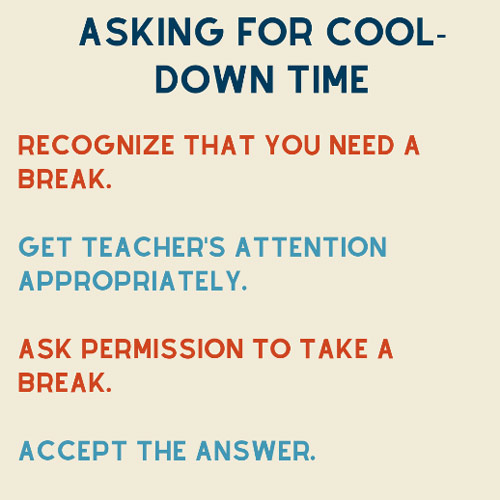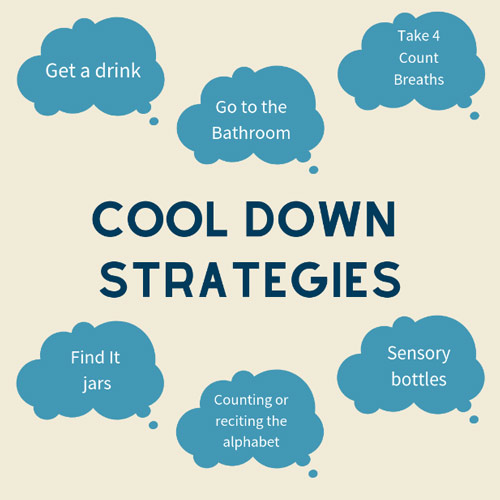
You just spent two days absorbing and processing a ton of new information. I’m guessing there are a ton of creative ideas that you’re excited to implement racing through your head! You’re inspired… but, where do you start? Here’s a quick list with a few ideas on where to begin:
1. Classroom Procedures – Sure this isn’t rocket science, however, run through the school day in your head. Where do find the most headaches throughout your day? Pencil sharpening? How students enter or exit the classroom? Submit classwork? Identifying those chaotic moments in the day and creating a quick three to five step procedure can help make those rough patches take a long vacation. Remember to practice these procedures regularly and at neutral times to keep them tight and fresh with your class.
For me personally, the pencil sharpener was my kryptonite. Whenever a student would ask to sharpen their pencil or I’d hear the sharpener go off, I’d become instantly annoyed. Students need functioning pencils, I get it, but I needed to find a way to preserve my sanity while making sure they had the necessary tools to complete their work. Here is how we did it in Miss Z.’s class:

It may seem simple, but having this routine in place and practiced alleviated a lot of headaches for my students and myself over the course of the year.
2. Teach Social Skills – Be intentional and carve out time within your day to practice social skills with your class. Follow your campus’s “Skill of the Week” (S.O.W) schedule, as developmentally appropriate. Younger grades tend to need more time focused on a smaller set of skills, while older grades may master a skill quickly or have more complex needs. Dedicating a set amount of time each day to social skills solidifies their importance.
When using Planned Teaching and other strategies for the S.O.W, remember that simply listening to an announcement and quick reason of the importance of the skill isn’t enough for most students to internalize the skill. Giving students a “kid friendly” reason to use the skill and practice are just two examples of how to better support internalized skill usage. Here’s an example of a S.O.W schedule:

Taking a few minutes to discuss the S.O.W and how they used it encourages them to genuinely find instances to use the skill and helps to build automaticity in usage throughout their lives.
3. Intentional Positive Reinforcement – When we’re talking positive reinforcement in the Boys Town Education Model®, we aren’t pulling an Oprah and giving out praise willy-nilly. Praise should be delivered with intentionality in mind. This means that yes, you may be giving praise to a student for simply “doing what they’re supposed to do.” However, if this same student typically struggles to meet expectations or usually has a major meltdown when asked to complete said task, think of the power that small moment of positivity has.
Positive reinforcement is meant to encourage students to replicate the desired behavior and if a student hasn’t built up the intrinsic motivation to do it on their own, it’s okay for us as adults to help them out with some external motivation. We also want to make sure that we are reinforcing behavior equally with academics, especially with our students that have a tendency to push boundaries with their behavior. Always be on the lookout for students doing what they are supposed to be doing and offer either general statements of approval or if the student tends to struggle, add on a little specificity by stating what they did well.
For example: Think of a student that typically gets your attention by shouting out your name, today they raise a quiet hand and wait for you to come to them. Since you know how hard it probably was for this student to demonstrate getting your attention appropriately, layer on some specific praise to encourage this student to continue to practice this skill. “Awesome job raising a quiet hand to get my attention!”
If you wanted to take it a step further, add on a reason why it was so valuable that they got your attention that way such as, “when you get my attention appropriately, I am more likely to give you my undivided attention.” This helps motivate them to do it again because they can connect how it benefits them.
Providing the what and the why alongside positive reinforcement guides students with some bigger misbehaviors to better understand why it is important for them to follow the expectations asked of them. It also supports and fosters a positive relationship between you and your students.
4. Help Keep Misbehaviors Small – We know that it’s not really a matter of “if” but “when” in terms of misbehavior. However, with a few tips, we can help keep those instances small, quick, and relatively painless.
a. We as the teacher need to manage ourselves and make sure we’re not leading with emotion when correcting a student.
b. Correct misbehaviors when they are small. Sometimes we have the urge to just let small things go until they become bigger issues that tend to elicit less controlled responses. Keep your tolerances low and your expectations high.
c. To help encourage a quick redirect is to go to the student and provide the correction in close proximity. This helps keep the correction between the two of you and discourages the student’s need to “save face” in front of their peers.
d. Sometimes students may not know what they should do, so providing a replacement behavior can help guide students back on track.
5. Time to Cool Down – One of our biggest goals is to help students manage themselves by having a sense of awareness about their needs. Let’s talk about how to create a system where students can advocate for themselves (with adult guidance from time to time) when they feel heated or upset.

When bringing in a procedure or routine, remember that we need to proactively teach students the expectations, in this case emotion recognition and using our cool-down time/space. We will want to clarify what they can do, where they can do it, and how long they can hang out in cool-down time.
Here are some examples of cool-down activities:

I hope you’ve found these reminders helpful and generated some ideas to kick start a new school year! Head over to boystowntraining.org if you have any questions or seek more examples to continue generating ideas!
If you have additional questions, please ask one of our experts!
 Lynnette Zurek – Boys Town National Training Consultant
Lynnette Zurek – Boys Town National Training Consultant
Bio: Lynnette holds a Master’s Degree of Elementary Education focused on curriculum and instruction from Arizona State University. She has worked in education for 11 years as an educator, interventionist, trainer, and instructional coach. Lynnette has implemented the Boys Town Education Model in the classroom, as well as provided training and support across multiple sites.
